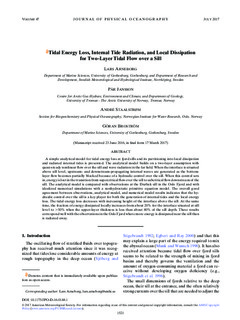| dc.contributor.author | Arneborg, Lars | |
| dc.contributor.author | Jansson, Pær | |
| dc.contributor.author | Staalstrøm, Andre | |
| dc.contributor.author | Broström, Göran | |
| dc.date.accessioned | 2018-06-14T14:28:56Z | |
| dc.date.available | 2018-06-14T14:28:56Z | |
| dc.date.created | 2017-05-03T10:51:56Z | |
| dc.date.issued | 2017 | |
| dc.identifier.citation | Journal of Physical Oceanography. 2017, 47 (7), 1521-1538. | nb_NO |
| dc.identifier.issn | 0022-3670 | |
| dc.identifier.uri | http://hdl.handle.net/11250/2501664 | |
| dc.description | This article is published by American Meteorological Society in Journal of Physical Oceanography, available online: https://www.ametsoc.org/index.cfm/ams/ . Embargo until 14.06.2018 | nb_NO |
| dc.description.abstract | A simple analytical model for tidal energy loss at fjord sills and its partitioning into local dissipation and radiated internal tides is presented. The analytical model builds on a two-layer assumption with quasi-steady nonlinear flow over the sill and wave radiation in the far field. When the interface is situated above sill level, upstream- and downstream-propagating internal waves are generated as the bottomlayer flow becomes partially blocked because of a hydraulic control over the sill. When this control sets in, energy is lost in the transition from supercritical flow over the sill to subcritical flow downstream of the sill. The analytical model is compared with observations at the Drøbak sill in the Oslo Fjord and with idealized numerical simulations with a nonhydrostatic primitive equation model. The overall good agreement between observations, analytical model, and numerical model results indicates that the hydraulic control over the sill is a key player for both the generation of internal tides and the local energy loss. The tidal energy loss decreases with increasing height of the interface above the sill. At the same time, the fraction of energy dissipated locally increases from about 20% for the interface situated at sill level to .50% when the upper-layer thickness is less than about 80% of the sill depth. These results correspond well with the observations in theOslo Fjord wheremore energy is dissipated near the sill than is radiated away. | nb_NO |
| dc.language.iso | eng | nb_NO |
| dc.publisher | American Meteorological Society | nb_NO |
| dc.title | Tidal Energy Loss, Internal Tide Radiation, and Local Dissipation for Two-Layer Tidal Flow over a Sill | nb_NO |
| dc.type | Journal article | nb_NO |
| dc.type | Peer reviewed | nb_NO |
| dc.description.version | publishedVersion | nb_NO |
| dc.rights.holder | 2017 American Meteorological Society. For information regarding reuse of this content and general copyright information, consult the AMS Copyright Policy (www.ametsoc.org/PUBSReuseLicenses). | nb_NO |
| dc.source.pagenumber | 1521-1538 | nb_NO |
| dc.source.volume | 47 | nb_NO |
| dc.source.journal | Journal of Physical Oceanography | nb_NO |
| dc.source.issue | 7 | nb_NO |
| dc.identifier.doi | 10.1175/JPO-D-16-0148.1 | |
| dc.identifier.cristin | 1467761 | |
| dc.relation.project | Norges forskningsråd: 184944 | nb_NO |
| dc.relation.project | Vetenskapsrådet: 621-2008-2689 | nb_NO |
| cristin.unitcode | 7464,20,14,0 | |
| cristin.unitname | Marin biogeokjemi og oseanografi | |
| cristin.ispublished | true | |
| cristin.fulltext | original | |
| cristin.qualitycode | 2 | |
